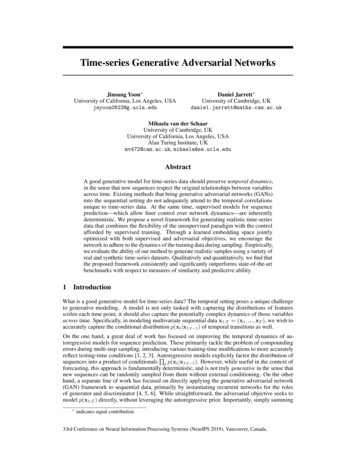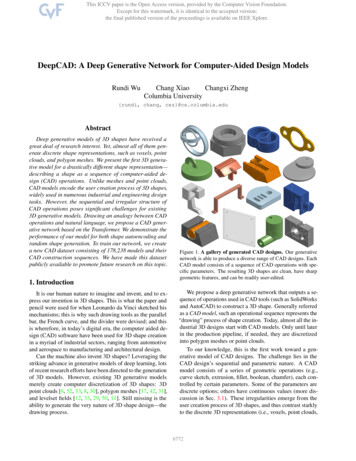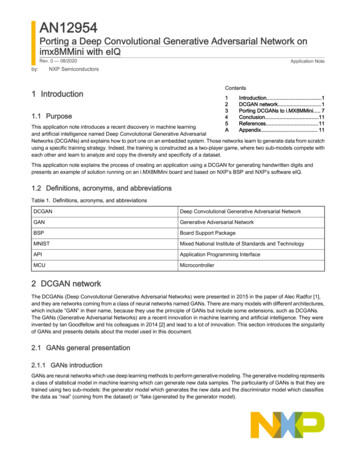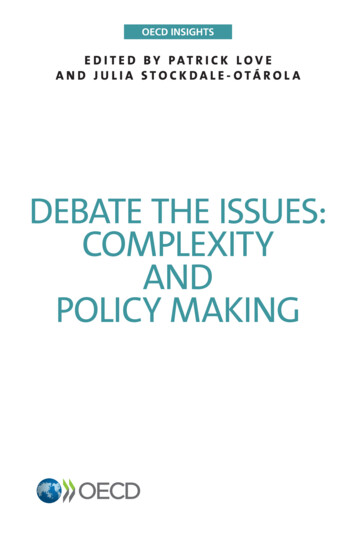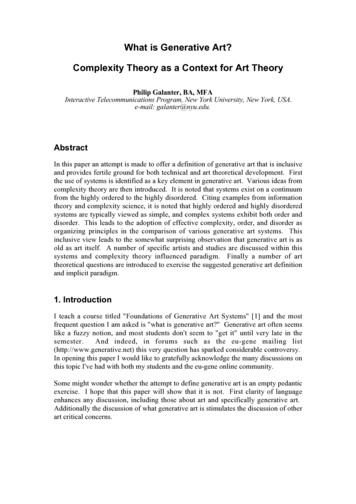
Transcription
What is Generative Art?Complexity Theory as a Context for Art TheoryPhilip Galanter, BA, MFAInteractive Telecommunications Program, New York University, New York, USA.e-mail: galanter@nyu.edu.AbstractIn this paper an attempt is made to offer a definition of generative art that is inclusiveand provides fertile ground for both technical and art theoretical development. Firstthe use of systems is identified as a key element in generative art. Various ideas fromcomplexity theory are then introduced. It is noted that systems exist on a continuumfrom the highly ordered to the highly disordered. Citing examples from informationtheory and complexity science, it is noted that highly ordered and highly disorderedsystems are typically viewed as simple, and complex systems exhibit both order anddisorder. This leads to the adoption of effective complexity, order, and disorder asorganizing principles in the comparison of various generative art systems. Thisinclusive view leads to the somewhat surprising observation that generative art is asold as art itself. A number of specific artists and studies are discussed within thissystems and complexity theory influenced paradigm. Finally a number of arttheoretical questions are introduced to exercise the suggested generative art definitionand implicit paradigm.1. IntroductionI teach a course titled "Foundations of Generative Art Systems" [1] and the mostfrequent question I am asked is "what is generative art?" Generative art often seemslike a fuzzy notion, and most students don't seem to "get it" until very late in thesemester.And indeed, in forums such as the eu-gene mailing list(http://www.generative.net) this very question has sparked considerable controversy.In opening this paper I would like to gratefully acknowledge the many discussions onthis topic I've had with both my students and the eu-gene online community.Some might wonder whether the attempt to define generative art is an empty pedanticexercise. I hope that this paper will show that it is not. First clarity of languageenhances any discussion, including those about art and specifically generative art.Additionally the discussion of what generative art is stimulates the discussion of otherart critical concerns.
2. Two Views of the Term “Generative Art”First a quick look at the term “generative art” from the bottom up, and from the topdown.2.1 From the Bottom Up – Clusters of Current Generative Art ActivityWith regard to the "what is generative art?" question one is often reminded of theparable of the blind men and the elephant. One blind man feeling the leg of theelephant says, "Surely an elephant is like a mighty tree". Another blind man, holdingthe trunk of the elephant says, "Surely an elephant is like a large snake". Yet anotherblind man, placing his hands on the sides of the elephant, exclaims, "Surely anelephant is like a great whale". And so on. In a similar way artists seems to all toooften define generative art as being most like the work that is closest at hand, namelytheir own generative art.And indeed there are clusters of contemporary generative art activity that are, in manyways, worlds onto themselves. Some of these include:Electronic Music and Algorithmic Composition - Dating at least to the seminal paperby Brooks, Hopkins, Neumann, and Wright in 1957 [2], those in the electronic musiccommunity have explored all manner of generative processes for the creation (at themacro level) of musical scores and (at the micro level) the subtle modulation ofperformance and timbre. This activity has not been limited to academic music. Arecent article in Electronic Musician, a magazine for working musicians, notes morethan a dozen programs using techniques as varied as cellular automata, fractals, a-life,L-systems, chaos, and of course randomization. [3]Computer Graphics and Animation - Well documented in the vast body of literaturepublished by the ACM SigGraph organization and others, computer graphicsresearchers have contributed to the realm of generative art for decades now.Examples of generative breakthroughs would include Perlin Noise [4] for thesynthesis of smoke, fire, and hair imagery, the use of L-systems to grow enoughvirtual plant life to populate entire forests and valleys [5], and the use of physicalmodeling to create animations that depict real world behavior without requiring theanimator to painstakingly choreograph every detail. These efforts have yieldedresults that reach far beyond the research community. Examples include animatedfeature length films such as those by Pixar and the hugely popular realm of videogame machines.The Demo Scene and VJ Culture - Borrowing from the above, youth culturemovements are taking generative technology out of the well funded labs, recordingstudios, and animation companies, and adapting low cost alternatives for use innightclubs and other social settings. For such artists and enthusiasts generative art isno longer obscure or esoteric, but rather an everyday method of creation.Randomization is the most frequently discussed technique, but others are workingtheir way into the scene as well.
Industrial Design and Architecture - Design practice has always included theiterative process of creating numbers of samples, selecting among them, makingincremental improvements and hybrid samples, again evaluating the results, and soon. This manual practice is quite reminiscent of the evolutionary process of geneticvariation and natural selection.It was seemingly inevitable that soon after the adoption of the computer by designersas a manual tool for CAD, there would follow the adoption of genetically inspiredalgorithms for the creation and selection of variations. In fact the generative artistWilliam Latham initially used an evolutionary system that existed purely on paper,and only later did he move to computerized versions. [6]Clearly any attempt to define generative art would have to include all of the above, asthere is no obvious reason to privilege one form of contemporary generative artpractice over another. And few would want to stop with just the above. One couldalso include, for example, robot art and math art as clusters of generative art activity.The fine arts offer a number of challenges in this regard. For example, in the 20thcentury a number of artists such as John Cage, William Burroughs, and MarcelDuchamp embraced randomization as a fecund generative principle. Minimalistssuch as Carl Andre, Mel Bochner, and Paul Morgenson used simple mathematicalprinciples to generate compositions. The conceptual artist Sol Lewitt usescombinatorial systems to create complex works from simple components, andconceptual artist Hans Haacke explored physical generative systems in his early work.And indeed some have wondered whether a painter like Kenneth Noland should beconsidered a generative artist given his “systemic art” practice, or whether JacksonPollock's drip and splash method qualifies as the kind of randomization that wouldplace his work in the realm of generative art. I, in fact, don't consider Noland andPollock to be generative artists. But given the dizzying variety generative art offers itis an entirely legitimate question to ask2.1 From the Top Down – Generative Art Considered LiterallyThe term generative art can also be explored from the top down by considering itsliteral abstract meaning.I often joke with my students that it is easy to tell if something is generative art. Firstit must be art, and second it must be generative. The joke here is, of course, I ambegging the question. One difficult question is replaced by two difficult questions.What do we mean by art, and what do we mean by generative?The "what is art?" question is often brought up to mock and sound a cautionary noteabout the perils of intellectual discourse rather than to pose a serious question. Butthis is mostly unfair. The discussion spawned by the question "what is art?" can infact be productive and useful. It has perhaps been best considered by specialists inaesthetics in the analytic school of philosophy found primarily in the U.S. and U.K.A recounting of this debate is beyond the scope of this paper but is well-summarizedelsewhere, for example Carrol’s book “Philosophy of Art”. [7]
Viable contemporary definitions of art generally include a notion akin to fuzzy settheory so that some things may be considered more fully art than others. In a similarway we can expect that some works are more fully generative art than others. Inaddition current notions about art recognize it as a social and historical notion thatchanges over time. To the extent generative art is art surely this must apply there aswell. But I hope to show that the generative aspect can be fixed in a more stable way.The word "generative" simply directs attention to a subset of art, a subset wherepotentially multiple results can be produced by using some kind of generating system.It is important to note here that if generative art also included art produced by anykind of generating idea, then generative art would include all art, and it would looseits utility as a distinct term.3. Generative Art DefinedSo a useful definition of generative art should (1) include known clusters of past andcurrent generative art activity, (2) allow for yet to be discovered forms of generativeart, (3) exist as a subset of all art while allowing that the definition of "art" can becontested, and (4) be restrictive enough that not all art is generative art.Whether considered from the top down or the bottom up, the defining aspect ofgenerative art seems to be the use of an autonomous system for art making. Here isthe definition I've been using in my class:Generative art refers to any art practice where the artist uses a system, suchas a set of natural language rules, a computer program, a machine, or otherprocedural invention, which is set into motion with some degree of autonomycontributing to or resulting in a completed work of art.The key element in generative art is then the system to which the artist cedes partialor total subsequent control. And with this definition some related art theory questionscome quickly to mind. A hint as to how that conversation might go will be offered atthe end of this paper.For now here are some observations about this definition. First, note that the termgenerative art is simply a reference to how the art is made, and it makes no claims asto why the art is made this way or what its content is. Second, generative art isuncoupled from any particular technology. Generative art may or may not be “hightech”. Third, a system that moves an art practice into the realm of generative art mustbe well defined and self-contained enough to operate autonomously.So if systems are in a sense the defining aspect of generative art, it is worth asking ifall systems alike, or if there is a useful way to sort them out and thus, by implication,sort out various kinds of generative art. This is the topic of the next few sections.
4. Complexity Science as a Context for UnderstandingSystems [27]Over the last 20 years or so scientists have attempted to create a new understanding ofsystems. Under the general rubric of "complexity science" and “complexity theory”various systems, and various kinds of systems, have been studied, compared,contrasted, and mathematically and computationally modeled. An abstractunderstanding of systems is beginning to emerge, and given that systems are adefining aspect of generative art, complexity science has much to offer the generativeartist. And indeed a great deal of the work presented at this very conference in pastyears is, explicitly or implicitly, rooted in complexity science.Science generally proceeds in a reductive manner, the thinking being that by breakingdown complicated phenomena into its figurative (or literal) atomic parts one gainspredictive and explanatory power. The problem with reductionism, however, is that itis often difficult to put the pieces back together again.This is especially true of complex systems. When scientists speak of complexsystems they don't mean systems that are complicated or perplexing in an informalway. The phrase "complex system" has been adopted as a specific technical term.Complex systems typically have a large number of small parts or components thatinteract with similar nearby parts and components. These local interactions often leadto the system organizing itself without any master control or external agent being "incharge". Such systems are often referred to as being self-organizing. These selforganized systems are also dynamic systems under constant change, and short ofdeath or destruction, they do not settle info a final stable "equilibrium" state. To theextent these systems react to changes in their environment so as to maintain theirintegrity, they are known as complex adaptive systems.In common language one is reminded of the saying that “the whole is greater than thesum of its parts.” Local components will interact in “nonlinear” ways, meaning thatthe interactions do more than merely add up they exponentiate. Examples ofcomplex systems are familiar to everyone. The weather, for example, forms coherentpatterns such as thunderstorms, tornados, and hot and cold fronts, yet there is nocentral mechanism or control that creates such patterns. Weather patterns “emerge”all over and all at once. In the near term weather can be predicted with someaccuracy, but beyond more than a few days the weather becomes quite unpredictable.The stock market is similarly a complex system with emergent properties. Billions ofshares and transactions are linked in a finite chain of cause and effect, and patternssuch as booms and busts emerge from the overall system. Yet no one factordominates or “plans” the market, and even with all of the relevant informationavailable to the public, the stock market generates surprising and unpredictablebehavior.Additional examples of complex systems include the brain (as studied by biologists)and the mind (as studied by psychologists), the predation and population cycles ofanimals in an ecosystem, the competition of genes and resulting evolution of a givenspecies, and the rise and fall of cultures and empires. Each of these systems consists
of many components (such as cells, chromosomes, citizens, etc.) that interact withother nearby components, and form a coherent pattern or entity without any centralcontrol or plan as to how that should happen.Thus complex systems often develop in ways that are dramatic, fecund, catastrophic,or so unpredictable as to seem random. Complexity science is a relatively new, andat times controversial, attempt to understand such systems by bridging a number oftraditionally distinct disciplines. The ambition is to understand the commonalitiessystems exhibit across all scales and hierarchies.Note that the study of complex systems also provides context and perspective forunderstanding simple systems. And the notion of generative art offered here includesboth complex and simple systems.5. Chaotic Systems and Random SystemsGenerative artists often use randomization. Complexity scientists often speak ofchaos. In many cases a chaotic system may seem random because its behavior is sounpredictable. But it is important to keep in mind that there is a difference.Complex systems often include chaotic behavior, which is to say that the dynamics ofthese systems are nonlinear and difficult to predict over time, even while the systemsthemselves are deterministic machines following a strict sequence of cause and effect.The nonlinearity of chaotic systems results in the amplification of small differences,and this is what makes them increasingly difficult to predict over time. This isusually referred to as sensitivity to initial conditions or "the butterfly effect", from thenotion that a butterfly flapping its wings in Hawaii can result in a tornado in Texas.[8]It is important to remember, especially within the context of generative art, thatchaotic systems are not random systems. Natural chaotic systems may be difficult topredict but they will still exhibit structure that is different than purely randomsystems.For example, even though it is difficult to predict the specific weather 6 months fromnow, we can be relatively sure it won't be 200 degrees outside, nor will we be getting30 feet of rain on a single day, and so on. The weather exists within some minimumand maximum limits, and those expectations are a sort of container for all possibleweather states. This is what scientists call the phase space, and it describes a sort ofconsistent general shape the chaotic system eventually traces out even though itremains unpredictable in precise detail.What about day to day weather transitions? The best predictor of tomorrow’s weatheris today’s weather. Even in my hometown of Chicago, known for its crazy weather, acold day is usually followed by another cold day. And a hot day is typically followedby a hot day. And so on. The transition from one weather state to another can bethought of as a path within the state space. Those paths are continuous (noinstantaneous jumps are allowed) and exhibit this form of local auto-correlation. In
other words unlike purely random systems chaotic systems have a sense of history.I find life to be more like a complex chaotic system and less like a simple randomone. There is uncertainty, but there is still a sense that cause and effect are at play. Imay not be able to make a specific prediction for a specific time, but I can know howthings tend to go. And I can often consider some things as impossibilities. There aresurprises, but not at every single turn because there are also correspondences.In a related way, artificial chaotic systems seem more like nature, and more like reallife, than artificial random systems. There is likely a lesson there for generativeartists.6. Notions of Order and Disorder in Information TheoryWhile we have an intuitive sense of what we mean when we refer to a system as"simple" or "complex" developing a formal technical measure of complexity thatcorresponds well to our intuitive sense is not easy.An earlier related attempt to better understand communication systems was initiatedby Claude Shannon in the form of information theory. [9] For the purposes ofanalyzing the capacity of a given communication channel, the core idea is that themore "surprise" a given communication can exhibit the more information it contains.For example, consider a channel that can only send the letter "A" at regular intervals.AAAAAAAAAAAAAAAAAAAAAEvery transmission is the same and allows for no modulation of the signal. It is, in asense, a highly ordered signal to the extreme. But even more, if all a channel can carryis the letter "A" there are no surprises, and thus no information can be transmitted.A channel that allows the sending of English language words like so:I LIKE GENERATIVE ARTcontains variation from character to character, and thus allows information to flow. Itshould be noted that information theory is not fundamentally about the transmissionof meaning, but rather the capacity to transmit symbols. The following nonsensesentence sent via the same channel:PAPER BIG WORK I CATSis about the same amount of information even though it is meaningless.
Natural language contains redundancy, which is another way of saying that the texthas consistent patterns, such as statistical frequencies of letter combinations that canpotentially be compressed out. For example, since we can anticipate the structure ofthe English language we might send the following compressed string with relativesuccess:I LIK GENARTIn the limiting case a signal in a channel that sends random letters is at maximuminformation. For example:FOEVQKMVKDYPQXCIHRSNWA truly random stream of characters is maximally disordered and has no underlyingstructure. Thus there are no patterns and redundancy to take advantage of, and nocompression is possible.While saying a highly ordered sting of repeating characters has low informationseems intuitively correct, saying a highly disordered string of random characters hasmaximum information seems peculiar. In terms of our human ability to extractmeaning from a given experience we require a mix of surprise and redundancy, i.e. asignal somewhere between extreme order and disorder.In his 1958 book "Information Theory and Esthetic Perception" Abraham Molesapplies these notions, along with findings from the realm of perceptual psychology, toanalyze the arts. [10] In line with the above, he attempts to apply various statisticalmeasures to classify musical works on a spectrum from "banal" to "novel"corresponding to the relative order versus disorder of the given information. Andindeed one can easily intuit that forms such as, for example, traditional folk music aremore ordered and banal than, say, free jazz which encourages more disorder andnovelty.At the extremes, however, highly ordered music (e.g. playing the same note over andover again) is of no greater intrinsic aesthetic interest than highly disordered music(e.g. playing entirely random pitches and durations). In terms of the pure esthetics wewill quickly lose interest in both. (Such performances might, however, be perfectlylegitimate given an appropriate conceptual framework providing context and thusmeaning).Working artists understand that an audience will quickly tire of both a highly orderedand a highly disordered aesthetic experience because both lack any structuralcomplexity worthy of their continued attention. The intuition that structure andcomplexity increase somewhere between the extremes of order and disorder leads usto the consideration of "effective complexity".
7. Algorithmic Complexity and Effective ComplexityComplex systems stand in contrast to simple systems, and attempts have been made toinvent measures that quantify the relative complexity of given systems. One approachis to consider the algorithmic complexity (AC) of a given system. Algorithmiccomplexity is also called the algorithmic information content (AIC), and wasindependently developed by Kolmogorov, Solomonoff, and Chaitin.It is known that in principle any system can be mapped into a smallest possibleprogram running on a universal computing machine generating a growing string asoutput over time. Some systems, such as fractals, require infinite time to generatebecause they have infinite detail. But that is not to say that fractals have infinitecomplexity. They are simple in the sense that they exhibit self-similar structure atevery scale. And, in fact, a fractal algorithm can be very compact indeed. [11]One might hope that AC or AIC is a good candidate for a measure of what weintuitively consider complexity. Perhaps the larger the algorithmic complexity themore complex the system.Figure 7.1Unfortunately, in the case of random processes we run into the same paradox as wesee in information theory.For our low information example the AIC would be very small, and independent ofstring length, because the algorithm could be very small. For example:loop:print "A"go to loopFor our intermediate information, English language, example the AIC would be a bitlarger. The redundancy of natural language allows the use of an algorithm that carriesa compressed version of the string and then expands it. For example the algorithm:print( expand( "NIFNEPOLDFIMDMEUMN" ) )
might result in the string:HERE IS THE MESSAGE AFTER IT HAS BEEN UNCOMPRESSEDUnfortunately in the case of a system that generates a purely random result the AICwill be quite a bit larger. Without redundant information in the string, in other wordswithout structure, no further lossless compression is possible. The smallest algorithmwould be a program that is a single "print" statement that includes the literal string inquestion. Thus for a random string the AIC is at least as long as the length of NEPMVU")Similar to what was previously shown, the AIC becomes larger the more random themessage is, and this conflicts with our intuitive sense of complexity. As Murray GellMann, one of the founders of the Sante Fe Institute and complexity science, puts it:"This property of AIC, which leads to its being called, on occasion,"algorithmic randomness,” reveals the unsuitability of the quantity asa measure of complexity, since the works of Shakespeare have aLower AIC than random gibberish of the same length that wouldtypically be typed by the proverbial roomful of monkeys."What is needed is a measure of "effective complexity" (EC) such that systems that arehighly ordered or disordered are given a low score, indicating simplicity, and systemsthat are some where in between are given a high score, indicating complexity, GellMann goes on to say:"A measure that corresponds much better to what is usually meant bycomplexity in ordinary conversation, as well as in scientific discourse,refers not to the length of the most concise description of an entity(which is roughly what AIC is), but to the length of a concisedescription of a set of the entity's regularities. Thus somethingalmost entirely random, with practically no regularities, would haveeffective complexity near zero. So would something completelyregular, such as a bit string consisting entirely of zeroes. Effectivecomplexity can be high only a region intermediate between totalorder and complete disorder"
Figure 7.2To measure EC Gell-Mann proposes to split a given system into two algorithmicterms, with the first algorithm capturing structure and the second algorithm capturingrandom deviation. The EC would then be proportional to the size of the optimallycompressed first algorithm that captures structure. There are objections to thisapproach, for example some maintain that this notion of structure is subjective andremains in the eye of the beholder. And indeed there are competing proposals as tothe specifics of effective complexity. [12]The important point for the purpose of this paper is that complexity science hasproduced a robust general paradigm for understanding and classifying systems.Systems exist on a continuum from the highly ordered to the highly disordered. Bothhighly ordered and highly disordered systems are simple. Complex systems exhibit amix of order and disorder.8. Generative Art Systems in the Context of ComplexityTheoryEarlier I offered a definition of generative art where the key is the use of systems asan indirect production method. This, taken in combination with the new paradigm forsystems suggested by complexity science, results in a paradigm for understanding andsorting though generative art systems.This paradigm for generative art systems is captured in the following figure, avariation on the previous figures from Gary Flakes wonderful book "theComputational Beauty of Nature". [13]
Figure 8.1First one should note that complexity is specific to a given system, and theclassifications shown here are generalities. Not all genetically inspired evolutionarysystems are going to be equally complex. Some L-systems are going to be moreordered than others, and some stochastic L-systems are going to be more disorderedthan others. Also some L-systems are equivalent to fractals, while others usingparametric and contextual mechanisms are more complex (as shown). [5]But if we accept this paradigm, that generative art is defined by the use of systems,and that systems can be best understood in the context of complexity theory, we arelead to an unusually broad and inclusive understanding of what generative art reallyis.And while it shouldn't be terribly surprising that the earliest forms of generative artused simple systems, some will find it surprising and perhaps even controversial thatgenerative art is as old as art itself.8.1 Highly Ordered Generative Art (and Generative Art as Old as ArtItself)In every time and place for which we can find artifacts, we find examples of the useof symmetry in the creation of art. Reasonable people can disagree as to at what pointthe use of symmetry can be considered an autonomous system. But even among themost so called primitive peoples examples abound in terms of the use of geometricpatterns in textiles, symmetric designs about a point, repeating border designs, and soon. Many of these are well documented in books by authors like Hargittai andHargittai [14] and Stevens. [15]The artistic use of tiling, in particular, is nothing less than the application of abstractsystems to decorate specific surfaces. Leading the most notable examples in thisregard are perhaps the masterworks found in the Islamic world. It is no coincidencethe Islamic world also provided one of the significant cradles of mathematical
innovation. It is also worth noting that the word "algorithm" has its roots in theIslamic world.Highly ordered systems in generative art also made their appearance in innovative20th century art. A popular contemporary tile artist, and student of the Islamic roots,is M. C. Escher. While lacking in formal mathematical training, it is clear that he hada significant understanding of the generative nature of what he called "the regulardivision of the plane". Without the use of computers he invented and applied whatcan only be called algorithms in the service of art. [16]In addition, minimal and conceptual artists such as Carl Andre, Mel Bochner, DonaldJudd, Paul Mogenson, Robert Smithson, and Sol Lewitt used various simple highlyordered geometric, number sequence, and combinatorial systems as generativeelements in their work. [17] [18]In my class I frequently remind my students that you don't need a computer to creategenerative art, and that in fact generative art existed long before computers. Withtongue only partially in cheek I also sometimes comment that generative art lead tothe invention of the computer!A highlight in the history of generative art was the invention of the Jacquard loom.Man
Clearly any attempt to define generative art would have to include all of the above, as there is no obvious reason to privilege one form of contemporary generative art practice over another. And few would want to stop with just the above. One could also include, for example, robot art and math art as clusters of generative art activity.

